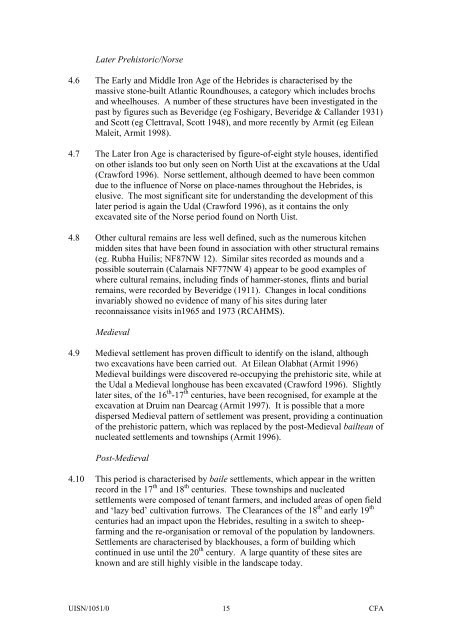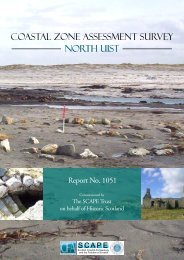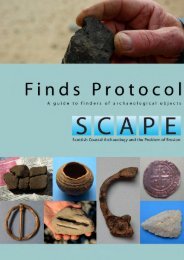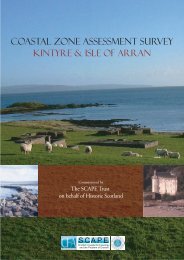download - SCAPE
download - SCAPE
download - SCAPE
You also want an ePaper? Increase the reach of your titles
YUMPU automatically turns print PDFs into web optimized ePapers that Google loves.
Later Prehistoric/Norse<br />
4.6 The Early and Middle Iron Age of the Hebrides is characterised by the<br />
massive stone-built Atlantic Roundhouses, a category which includes brochs<br />
and wheelhouses. A number of these structures have been investigated in the<br />
past by figures such as Beveridge (eg Foshigary, Beveridge & Callander 1931)<br />
and Scott (eg Clettraval, Scott 1948), and more recently by Armit (eg Eilean<br />
Maleit, Armit 1998).<br />
4.7 The Later Iron Age is characterised by figure-of-eight style houses, identified<br />
on other islands too but only seen on North Uist at the excavations at the Udal<br />
(Crawford 1996). Norse settlement, although deemed to have been common<br />
due to the influence of Norse on place-names throughout the Hebrides, is<br />
elusive. The most significant site for understanding the development of this<br />
later period is again the Udal (Crawford 1996), as it contains the only<br />
excavated site of the Norse period found on North Uist.<br />
4.8 Other cultural remains are less well defined, such as the numerous kitchen<br />
midden sites that have been found in association with other structural remains<br />
(eg. Rubha Huilis; NF87NW 12). Similar sites recorded as mounds and a<br />
possible souterrain (Calarnais NF77NW 4) appear to be good examples of<br />
where cultural remains, including finds of hammer-stones, flints and burial<br />
remains, were recorded by Beveridge (1911). Changes in local conditions<br />
invariably showed no evidence of many of his sites during later<br />
reconnaissance visits in1965 and 1973 (RCAHMS).<br />
Medieval<br />
4.9 Medieval settlement has proven difficult to identify on the island, although<br />
two excavations have been carried out. At Eilean Olabhat (Armit 1996)<br />
Medieval buildings were discovered re-occupying the prehistoric site, while at<br />
the Udal a Medieval longhouse has been excavated (Crawford 1996). Slightly<br />
later sites, of the 16 th -17 th centuries, have been recognised, for example at the<br />
excavation at Druim nan Dearcag (Armit 1997). It is possible that a more<br />
dispersed Medieval pattern of settlement was present, providing a continuation<br />
of the prehistoric pattern, which was replaced by the post-Medieval bailtean of<br />
nucleated settlements and townships (Armit 1996).<br />
Post-Medieval<br />
4.10 This period is characterised by baile settlements, which appear in the written<br />
record in the 17 th and 18 th centuries. These townships and nucleated<br />
settlements were composed of tenant farmers, and included areas of open field<br />
and ‘lazy bed’ cultivation furrows. The Clearances of the 18 th and early 19 th<br />
centuries had an impact upon the Hebrides, resulting in a switch to sheepfarming<br />
and the re-organisation or removal of the population by landowners.<br />
Settlements are characterised by blackhouses, a form of building which<br />
continued in use until the 20 th century. A large quantity of these sites are<br />
known and are still highly visible in the landscape today.<br />
UISN/1051/0<br />
15<br />
CFA









